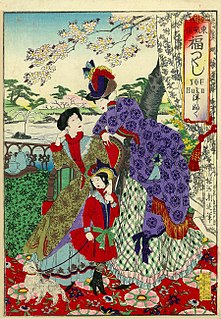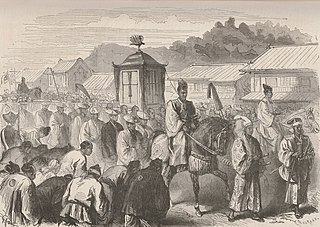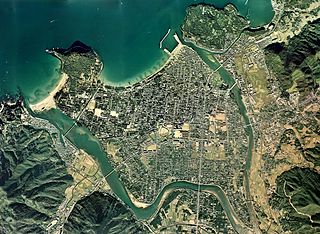 W
WAtomi Kakei was a Japanese calligrapher, Maruyama school painter, scholar of Sino-Japanese studies, and Meiji period educator. She founded the Atomi School in 1875 in Kanda, Tokyo, one of the oldest women's universities in Japan.
 W
WThe 1888 eruption of Mount Bandai was a major volcanic eruption which occurred during the Meiji period of the Empire of Japan. The eruption occurred on July 15, 1888, and pyroclastic flows buried villages on the northern foot of the mountain, and devastated the eastern part of Bandai region, Iwashiro Province north of Tokyo. At least 477 people were killed and hundreds more were injured and rendered homeless in what became the worst volcanic disaster in recent Japanese history.
 W
WThe Chichibu incident was a large-scale peasant revolt in November 1884 in Chichibu, Saitama, a short distance from Japan's capital. It lasted about two weeks.
 W
WEmperor Meiji , also called Meiji the Great , or Meiji the Good , was the 122nd emperor of Japan according to the traditional order of succession, reigning from 3 February 1867 until his death on 30 July 1912, and the first monarch of the Empire of Japan. He presided over the Meiji era, a time of rapid change that witnessed Japan's transformation from an isolationist, feudal state to an industrialized world power.
 W
WChujiro Hayashi , a disciple of Mikao Usui, played a major role in the transmission of Reiki out of Japan and for turning it into a less mystical practice.
 W
WJapanese clothing during the Meiji period was quite different from earlier periods. During this time, Western-style fashion (yofuku) was introduced into the government, indicating a move to modernity. During the Meiji period, certain jobs required Western-style uniform, starting with the Japanese government in 1872. Western-style dress thus became associated with elitism, modernity, and money. The Western trends adopted by the government were not popular with the public at large. While those in the Imperial court, office jobs, factory workers, or other various job holders might wear them as uniform, many people still chose to wear kimono and other traditional Japanese clothing (wafuku).
 W
WThe Japanese invasion of Taiwan was a conflict between the Empire of Japan and the armed forces of the short-lived Republic of Formosa following the Qing Dynasty's cession of Taiwan to Japan in April 1895 at the end of the First Sino-Japanese War. The Japanese sought to take control of their new possession, while the Republican forces fought to resist Japanese occupation. The Japanese landed near Keelung on the northern coast of Taiwan on 29 May 1895, and in a five-month campaign swept southwards to Tainan. Although their advance was slowed by guerrilla activity, the Japanese defeated the Formosan forces whenever they attempted to make a stand. The Japanese victory at Baguashan on 27 August, the largest battle ever fought on Taiwanese soil, doomed the Formosan resistance to an early defeat. The fall of Tainan on 21 October ended organised resistance to Japanese occupation, and inaugurated five decades of Japanese rule in Taiwan.
 W
WThe Japanese punitive expedition to Taiwan in 1874, referred to in Japan as the Taiwan Expedition and in Taiwan and China as the Mudan incident, was a punitive expedition launched by the Japanese in retaliation for the murder of 54 Ryukyuan sailors by Paiwan aborigines near the southwestern tip of Taiwan in December 1871. The success of the expedition, which marked the first overseas deployment of the Imperial Japanese Army and Imperial Japanese Navy, revealed the fragility of the Qing dynasty's hold on Taiwan and encouraged further Japanese adventurism. Diplomatically, Japan's embroilment with China in 1874 was eventually resolved by a British arbitration under which Qing China agreed to compensate Japan for property damage. Some ambiguous wording in the agreed terms were later argued by Japan to be confirmation of Chinese renunciation of suzerainty over the Ryukyu Islands, paving the way for de facto Japanese incorporation of Ryukyu in 1879.
 W
WMeiji Memorial Picture Gallery is a gallery commemorating the "imperial virtues" of Japan's Meiji Emperor, installed on his funeral site in the Gaien or outer precinct of Meiji Shrine in Tōkyō. The gallery is one of the earliest museum buildings in Japan and itself an Important Cultural Property.
 W
WThe Meiji era is an era of Japanese history that extended from October 23, 1868 to July 30, 1912. The Meiji era was the first half of the Empire of Japan, when the Japanese people moved from being an isolated feudal society at risk of colonization by Western powers to the new paradigm of a modern, industrialized nation state and emergent great power, influenced by Western scientific, technological, philosophical, political, legal, and aesthetic ideas. As a result of such wholesale adoption of radically different ideas, the changes to Japan were profound, and affected its social structure, internal politics, economy, military, and foreign relations. The period corresponded to the reign of Emperor Meiji. It was preceded by the Keiō era and was succeeded by the Taishō era, upon the accession of Emperor Taishō.
 W
WThe Meiji Restoration , referred to at the time as the Honorable Restoration , and also known as the Meiji Renovation, Revolution, Reform, or Renewal, was a political event that restored practical imperial rule to Japan in 1868 under Emperor Meiji. Although there were ruling emperors before the Meiji Restoration, the events restored practical abilities and consolidated the political system under the Emperor of Japan. The goals of the restored government were expressed by the new emperor in the Charter Oath.
 W
WThe Ministry of Public Works was a cabinet-level ministry in the Daijō-kan system of government of the Meiji period Empire of Japan from 1870-1885. It is also sometimes referred to as the “Ministry of Engineering” or “Ministry of Industry”.
 W
WSites of Japan's Meiji Industrial Revolution: Iron and Steel, Shipbuilding and Coal Mining are a group of historic sites that played an important part in the industrialization of Japan in the Bakumatsu and Meiji periods, and are part of the industrial heritage of Japan. In 2009 the monuments were submitted jointly for inscription on the UNESCO World Heritage List under criteria ii, iii, and iv. The sites were accepted at the 39th UNESCO World Heritage session.
 W
WThe National Industrial Exhibitions were a series of five exhibitions in Meiji Japan, staged between 1877 and 1903, the first three in Tokyo, the fourth in Kyoto, the last in Osaka.
 W
WRyūkyū Disposition , also Disposition of the Ryūkyūs, dispositions relating to the Ryūkyūs, Ryukyu Annexation or Annexation of Okinawa, was the political process during the early years of the Meiji period that saw the incorporation of the former Ryūkyū Kingdom into the Empire of Japan as Okinawa Prefecture and its decoupling from the Chinese tributary system. These processes began with the creation of Ryūkyū Domain in 1872 and culminated in the kingdom's annexation and final dissolution in 1879; immediate diplomatic fallout and consequent negotiations with Qing China, brokered by Ulysses S. Grant, effectively came to an end late the following year. The term is also sometimes used more narrowly in relation to the events and changes of 1879 alone. The Ryūkyū Disposition has been "alternatively characterized as aggression, annexation, national unification, or internal reform".
 W
WSatsuma ware is a type of Japanese pottery originally from Satsuma Province, southern Kyūshū. Today, it can be divided into two distinct categories: the original plain dark clay early Satsuma made in Satsuma from around 1600, and the elaborately decorated export Satsuma ivory-bodied pieces which began to be produced in the nineteenth century in various Japanese cities. By adapting their gilded polychromatic enamel overglaze designs to appeal to the tastes of western consumers, manufacturers of the latter made Satsuma ware one of the most recognized and profitable export products of the Meiji period.
 W
WThe Shi-gakkō or Shigakkō was a system of military academies in Kagoshima Prefecture, Japan during the early Meiji era. Created by Saigō Takamori, the building of these schools and the organization of a political clique inside its walls was a cause of the Satsuma Rebellion. Many officers involved in the rebellion on the side of the Satsuma Domain were graduates of the Shi-gakkō. The main site was located in Shiroyama-chō, Kagoshima, on the site of the current National Hospital Organization Kagoshima Medical Center.
 W
WThe 1894 Tokyo earthquake occurred in Tokyo, Japan at 14:04 PM on June 20. It affected downtown Tokyo and neighboring Kanagawa prefecture, especially the cities of Kawasaki and Yokohama.
 W
WUeno Park is a spacious public park in the Ueno district of Taitō, Tokyo, Japan. The park was established in 1873 on lands formerly belonging to the temple of Kan'ei-ji. Amongst the country's first public parks, it was founded following the western example as part of the borrowing and assimilation of international practices that characterizes the early Meiji period. The home of a number of major museums, Ueno Park is also celebrated in spring for its cherry blossoms and hanami. In recent times the park and its attractions have drawn over ten million visitors a year, making it Japan's most popular city park.
 W
WThe Yahata Steel Works is a steel mill in Kitakyūshū, Fukuoka Prefecture, Japan. Imperial Steel Works was established in 1896 to meet increasing demand from the nation's burgeoning shipbuilding, railway, construction, and armaments industries. The site chosen was the former town of Yahata, now merged into Kitakyūshū, near coal mines and with easy access to the sea.